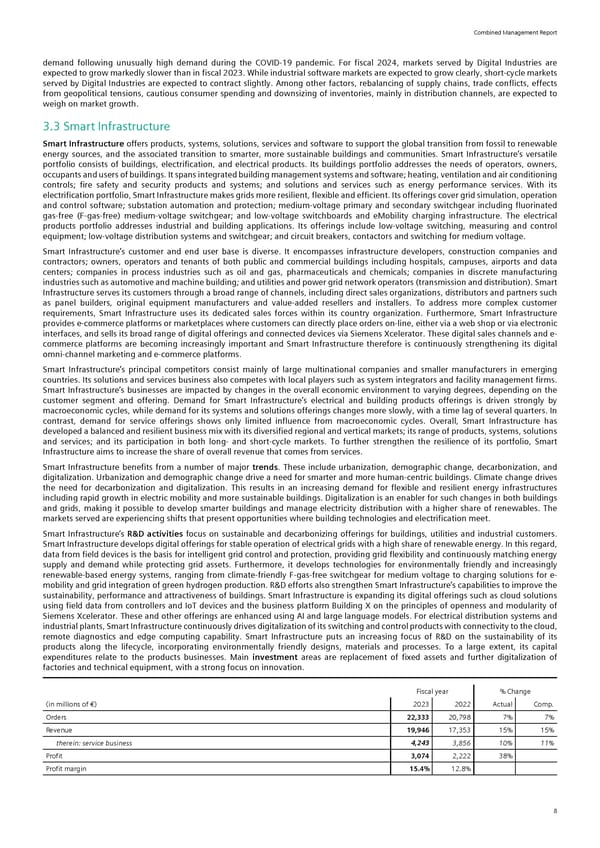Combined Management Report demand following unusually high demand during the COVID-19 pandemic. For fiscal 2024, markets served by Digital Industries are expected to grow markedly slower than in fiscal 2023. While industrial software markets are expected to grow clearly, short-cycle markets served by Digital Industries are expected to contract slightly. Among other factors, rebalancing of supply chains, trade conflicts, effects from geopolitical tensions, cautious consumer spending and downsizing of inventories, mainly in distribution channels, are expected to weigh on market growth. 3.3 Smart Infrastructure Smart Infrastructure offers products, systems, solutions, services and software to support the global transition from fossil to renewable energy sources, and the associated transition to smarter, more sustainable buildings and communities. Smart Infrastructure’s versatile portfolio consists of buildings, electrification, and electrical products. Its buildings portfolio addresses the needs of operators, owners, occupants and users of buildings. It spans integrated building management systems and software; heating, ventilation and air conditioning controls; fire safety and security products and systems; and solutions and services such as energy performance services. With its electrification portfolio, Smart Infrastructure makes grids more resilient, flexible and efficient. Its offerings cover grid simulation, operation and control software; substation automation and protection; medium-voltage primary and secondary switchgear including fluorinated gas-free (F-gas-free) medium-voltage switchgear; and low-voltage switchboards and eMobility charging infrastructure. The electrical products portfolio addresses industrial and building applications. Its offerings include low-voltage switching, measuring and control equipment; low-voltage distribution systems and switchgear; and circuit breakers, contactors and switching for medium voltage. Smart Infrastructure’s customer and end user base is diverse. It encompasses infrastructure developers, construction companies and contractors; owners, operators and tenants of both public and commercial buildings including hospitals, campuses, airports and data centers; companies in process industries such as oil and gas, pharmaceuticals and chemicals; companies in discrete manufacturing industries such as automotive and machine building; and utilities and power grid network operators (transmission and distribution). Smart Infrastructure serves its customers through a broad range of channels, including direct sales organizations, distributors and partners such as panel builders, original equipment manufacturers and value-added resellers and installers. To address more complex customer requirements, Smart Infrastructure uses its dedicated sales forces within its country organization. Furthermore, Smart Infrastructure provides e-commerce platforms or marketplaces where customers can directly place orders on-line, either via a web shop or via electronic interfaces, and sells its broad range of digital offerings and connected devices via Siemens Xcelerator. These digital sales channels and e- commerce platforms are becoming increasingly important and Smart Infrastructure therefore is continuously strengthening its digital omni-channel marketing and e-commerce platforms. Smart Infrastructure’s principal competitors consist mainly of large multinational companies and smaller manufacturers in emerging countries. Its solutions and services business also competes with local players such as system integrators and facility management firms. Smart Infrastructure’s businesses are impacted by changes in the overall economic environment to varying degrees, depending on the customer segment and offering. Demand for Smart Infrastructure’s electrical and building products offerings is driven strongly by macroeconomic cycles, while demand for its systems and solutions offerings changes more slowly, with a time lag of several quarters. In contrast, demand for service offerings shows only limited influence from macroeconomic cycles. Overall, Smart Infrastructure has developed a balanced and resilient business mix with its diversified regional and vertical markets; its range of products, systems, solutions and services; and its participation in both long- and short-cycle markets. To further strengthen the resilience of its portfolio, Smart Infrastructure aims to increase the share of overall revenue that comes from services. Smart Infrastructure benefits from a number of major trends. These include urbanization, demographic change, decarbonization, and digitalization. Urbanization and demographic change drive a need for smarter and more human-centric buildings. Climate change drives the need for decarbonization and digitalization. This results in an increasing demand for flexible and resilient energy infrastructures including rapid growth in electric mobility and more sustainable buildings. Digitalization is an enabler for such changes in both buildings and grids, making it possible to develop smarter buildings and manage electricity distribution with a higher share of renewables. The markets served are experiencing shifts that present opportunities where building technologies and electrification meet. Smart Infrastructure’s R&D activities focus on sustainable and decarbonizing offerings for buildings, utilities and industrial customers. Smart Infrastructure develops digital offerings for stable operation of electrical grids with a high share of renewable energy. In this regard, data from field devices is the basis for intelligent grid control and protection, providing grid flexibility and continuously matching energy supply and demand while protecting grid assets. Furthermore, it develops technologies for environmentally friendly and increasingly renewable-based energy systems, ranging from climate-friendly F-gas-free switchgear for medium voltage to charging solutions for e- mobility and grid integration of green hydrogen production. R&D efforts also strengthen Smart Infrastructure’s capabilities to improve the sustainability, performance and attractiveness of buildings. Smart Infrastructure is expanding its digital offerings such as cloud solutions using field data from controllers and IoT devices and the business platform Building X on the principles of openness and modularity of Siemens Xcelerator. These and other offerings are enhanced using AI and large language models. For electrical distribution systems and industrial plants, Smart Infrastructure continuously drives digitalization of its switching and control products with connectivity to the cloud, remote diagnostics and edge computing capability. Smart Infrastructure puts an increasing focus of R&D on the sustainability of its products along the lifecycle, incorporating environmentally friendly designs, materials and processes. To a large extent, its capital expenditures relate to the products businesses. Main investment areas are replacement of fixed assets and further digitalization of factories and technical equipment, with a strong focus on innovation. Fiscal year % Change (in millions of €) 2023 2022 Actual Comp. Orders 22,333 20,798 7% 7% Revenue 19,946 17,353 15% 15% therein: service business 4,243 3,856 10% 11% Profit 3,074 2,222 38% Profit margin 15.4% 12.8% 8
 Siemens Report FY2023 Page 9 Page 11
Siemens Report FY2023 Page 9 Page 11